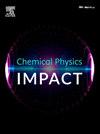二氧化硅支架上三步制备TiO2CdS球以增强析氢性能
IF 4.3
Q2 CHEMISTRY, PHYSICAL
引用次数: 0
摘要
开发新型、低成本、高效的析氢电催化剂是实现可持续能源应用的关键。在这项研究中,二氧化硅负载的TiO2CdS球形复合材料作为一种高效的催化剂,增强了析氢性能。该复合材料是通过材料工程的三步工艺合成的。XRD分析显示SiO2的峰值强度降低(25°),而UV-vis数据显示cd掺入后SiO2的带隙从2.63 eV缩小到2.11 eV,证实了表面改性和可见光响应性。FTIR发现了Ti-O-Cd相互作用和O-H弯曲振动,而TEM成像显示了均匀的SiO2球体(200-250 nm)和密集的CdS覆盖,证实了成功的分层集成。最后,通过电化学测试来评价材料的电催化HER性能。当电流密度为10 mA/cm²时,过电位从793 mV显著降低到264 mV,表明随着cd浓度的增加,电催化效率有所提高。此外,Tafel斜率分析表明,随着cd含量的增加,析氢动力学增强,斜率从189 mV/dec减小到127 mV/dec。电化学阻抗谱(EIS)结果显示,所有样品的Nyquist图呈半圆形,含cd最高的样品呈现较小的半圆形,表明电荷转移电阻大幅降低。本文章由计算机程序翻译,如有差异,请以英文原文为准。

Three-step fabrication of TiO2CdS spheres on SiO2 supports for enhanced hydrogen evolution performance
Development of novel, low-cost and efficient electrocatalysts for hydrogen evolution reaction (HER) is crucial for sustainable energy applications. In this study, a SiO2-supported TiO2![]() CdS spherical composite is presented as a highly effective catalyst for enhanced hydrogen evolution performance. This composite material was synthesized through a three-step process of materials engineering. XRD analysis revealed reduced SiO2 peak intensity (25°) while UV–vis data indicate a narrowed bandgap (from 2.63 eV to 2.11 eV) with CdS incorporation, confirming surface modification and visible-light responsiveness. FTIR identified Ti–O–Cd interactions and O–H bending vibrations, while TEM imaging demonstrated uniform SiO2 spheres (200–250 nm) with dense CdS coverage, corroborating successful hierarchical integration. Finally, electrochemical measurements were performed to evaluate the material's electrocatalytic HER performance. The overpotential exhibited a notable decrease from 793 mV to 264 mV at a current density of 10 mA/cm², demonstrating the improved electrocatalytic efficiency as CdS concentration increased. Furthermore, Tafel slope analysis revealed enhanced hydrogen evolution kinetics, with the slope reducing from 189 to 127 mV/dec as CdS content increased. Electrochemical impedance spectroscopy (EIS) results revealed semicircular Nyquist plots for all samples, with the highest CdS-containing sample showing a smaller semicircle, indicating a substantial reduction in charge transfer resistance.
CdS spherical composite is presented as a highly effective catalyst for enhanced hydrogen evolution performance. This composite material was synthesized through a three-step process of materials engineering. XRD analysis revealed reduced SiO2 peak intensity (25°) while UV–vis data indicate a narrowed bandgap (from 2.63 eV to 2.11 eV) with CdS incorporation, confirming surface modification and visible-light responsiveness. FTIR identified Ti–O–Cd interactions and O–H bending vibrations, while TEM imaging demonstrated uniform SiO2 spheres (200–250 nm) with dense CdS coverage, corroborating successful hierarchical integration. Finally, electrochemical measurements were performed to evaluate the material's electrocatalytic HER performance. The overpotential exhibited a notable decrease from 793 mV to 264 mV at a current density of 10 mA/cm², demonstrating the improved electrocatalytic efficiency as CdS concentration increased. Furthermore, Tafel slope analysis revealed enhanced hydrogen evolution kinetics, with the slope reducing from 189 to 127 mV/dec as CdS content increased. Electrochemical impedance spectroscopy (EIS) results revealed semicircular Nyquist plots for all samples, with the highest CdS-containing sample showing a smaller semicircle, indicating a substantial reduction in charge transfer resistance.
求助全文
通过发布文献求助,成功后即可免费获取论文全文。
去求助
来源期刊

Chemical Physics Impact
Materials Science-Materials Science (miscellaneous)
CiteScore
2.60
自引率
0.00%
发文量
65
审稿时长
46 days
 求助内容:
求助内容: 应助结果提醒方式:
应助结果提醒方式:


